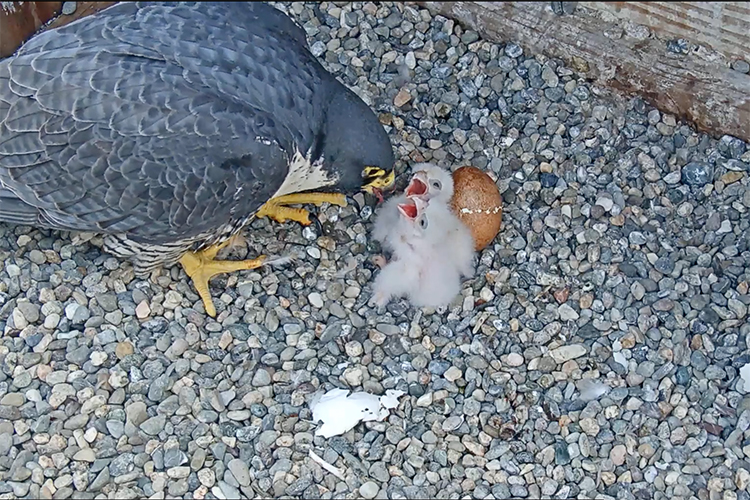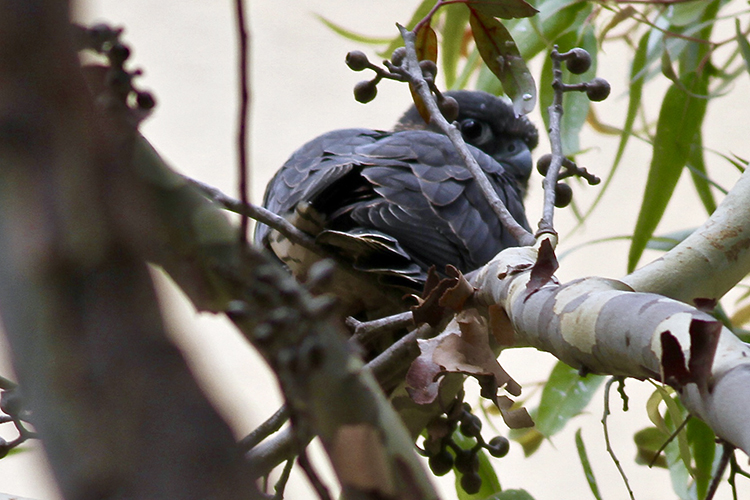Campanile peregrine falcon chicks make their big screen debut
More than 500 people stopped by BAMPFA on April 25 to watch the new peregrine chicks on the huge outdoor screen

April 26, 2019
For the third time, Annie and Grinnell — the peregrine falcon pair who made the Campanile their home in 2017 — have become proud parents of new chicks.

In February of this year, two cameras were installed on the second balcony, so people can watch the peregrines all day, every day. One camera (below) is clamped on the balustrade right in front of the nest box. The other is in the tower’s northeast corner, where chicks spend a lot of time running around and flapping their wings before they take their first flight.

More than 500 people — and several reporters — stopped by throughout the day to watch the new family and ask questions of the peregrine experts who were stationed outside. “Part of our vision is to be a cultural town square,” said Ann Wiens, communications director for BAMPFA. “This seemed perfect because science and art are both about discovery. They’re both about observation. They’re both about seeing things in a new way.”

Two chicks have hatched so far — one at about 5 p.m. and one at 10 p.m. on April 24 — and a third could still emerge from its shell. There is a chance, though, that it won’t hatch. “It’s very hard work getting out of an egg,” said Mary Malec, a volunteer raptor nest monitor for the Golden Gate Raptor Observatory and East Bay Regional Park District. “Sometimes they get only partway through the process.”

Now that the couple has new chicks to care for, Grinnell will be busy catching prey for his family. In urban areas, peregrines eat a lot of pigeons because they’re everywhere. But they also eat other birds, like mourning dove, jay, starling, coot and crow. Each chick will eat about five ounces of food per day — about 1/3 of a pigeon-sized bird — until they learn to hunt on their own after about six weeks.
For about 10 days after the chicks hatch, the peregrine parents will sit on the babies to keep them warm until they begin to thermoregulate. Leading up to their hatch, Annie sat on the eggs for more than a month. “She just sat for hours and hours,” said Malec. “Being able to watch it in real time, you have a much greater appreciation for how difficult this is.”

The peregrine falcon is the fastest animal in the world — three times faster than a cheetah. They can reach speeds of more than 200 miles per hour when they dive for prey. This diving is called a stoop.

(UC Berkeley photo by Maria Garcia Alvarez)
Peregrine falcons were once on the brink of extinction, in large part caused by the widespread use of the pesticide DDT and the country’s misguided assault on predatory animals. In the early 1970s, however, peregrine falcons caught a break. DDT was banned and the Endangered Species Act was passed, among other wildlife regulatory laws. In the years since, peregrines have made a remarkable comeback. Peregrine falcons are still a federally protected species under the Migratory Bird Treaty Act. It is illegal to disturb nesting peregrines, and only authorized personnel can enter the Campanile’s second balcony during nesting season.

Last year’s peregrine falcon chicks were named Berkelium, Lawrencium and Californium, after three elements discovered at Berkeley. (UC Berkeley photo by Maria Garcia Alvarez)
When the chicks are about 24 days old, experts will band them. By then, their bodies will be almost full grown. They will go from about 1 ounce to 2.2 pounds in just three weeks. Bird banding has been a formal program through the U.S. Fish and Wildlife Service for over 100 years. It helps us learn about how long peregrines live and where they go.

Fledgling Fiat — from the first clutch in 2017 — rests in a tree near Stephens Hall after taking her first flight off the Campanile. (Photo by Mary Malec)
Peregrine chicks usually take their first flight — called fledging — when they’re 40 to 43 days old. The peregrine chicks will leave the area anywhere from two to three months after fledging. Peregrines usually travel about 30 to 50 miles away from their natal area, but could go as far as hundreds of miles away. And they probably won’t be back. They’d be seen as intruders and chased away.

(Photo by Maria Garcia Alvarez)
The couple will stay on the Campanile year round defending their prime territory, with its great views and ample food supply. Listen to how they live and hunt on our podcast, Fiat Vox. See photos and read the story.
See the latest photos, videos and descriptions of the peregrines’ behavior — and ask questions — on the Cal Falcons Facebook page.